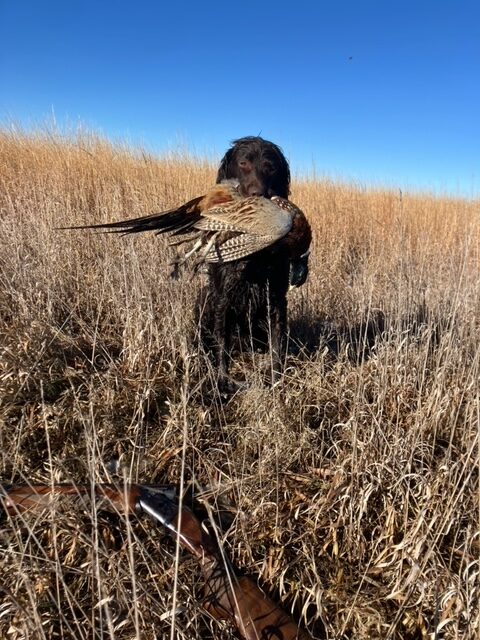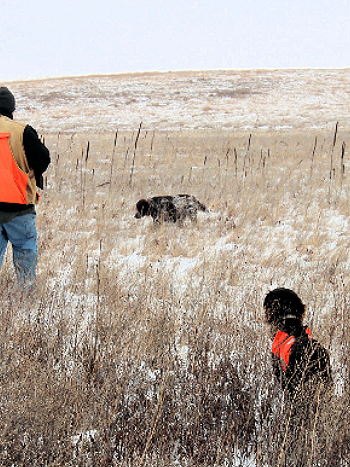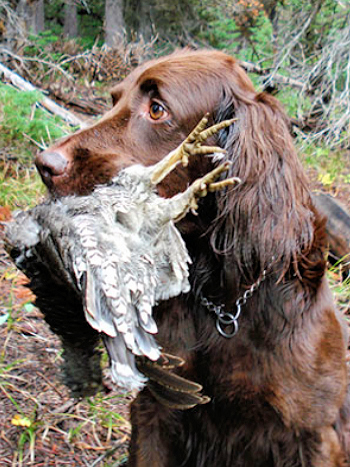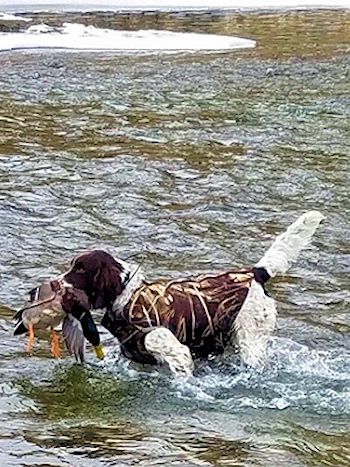The German Longhaired Pointer (The Deutsch-Langhaar)
The history of long-coated hunting dogs in Germany appears to be an old one. In the Middle Ages, the dogs spoken of as “hawk dogs”, “grouse dogs”, and “water dogs” were all long-haired. We are able to tell this because the characteristics these dogs had were preserved in the art depicting hunting during these times.
dogs spoken of as “hawk dogs”, “grouse dogs”, and “water dogs” were all long-haired. We are able to tell this because the characteristics these dogs had were preserved in the art depicting hunting during these times.
The bird hunting dog mentioned in the teutonic codes of law was long-coated. These dogs combined with the Medieval Wachtelhund and other long-haired breeds were the beginning of the German longhaired pointing breeds of which there are now three: the Deutsch-Langhaar, the Large Munsterlander and the Small Munsterlander. Many of the same traits that are valued today in sporting dogs were also fostered in the forerunners of the German Long-haired pointing breeds. Eager retrieving, calmness and thoroughness during the search, along with staunch pointing were valued in certain lines.
With the disappearance of large areas of dense forest in Central Europe, more and more hunting took place in fields, and the pointing dogs became a good deal more valued. Pointing, which often meant crouching or lying down, was valued especially by bird hunters who used nets or “Tyras”, which were often thrown over both dogs and game. This was, of course, before the advent of wing shooting. The perfecting of firearms used for wing shooting brought about a change in both hunting and hunting dogs. Even at this time, an all around utility dog was being sought. This pursuit involved a multitude of trial matings, some with positive results.
At this time, the pointer was widely favored, but unlike his English cousin, the pointer of Central Europe was quite heavy and slow. The hunter searched the field thoroughly with the dog about 50 paces in front. These dogs were also reliable retrievers of lost birds, as well as being useful for water work and tracking. For a time, pointers imported from England experienced a great deal of popularity in Germany, although these dogs had talents that made them very desirable for certain aspects of field work, their use a breeding stock diluted many of the qualities sought after in the more versatile hunting dogs. The German longhaired breeds were least affected by this addition of pointer blood. The Deutsch-Langhaar or German Longhaired Pointer remained the “Old Forester’s Dog”.
In 1879, the best examples of the Longhaired German Pointers were selected at an exhibition in Hannover, and were given the first breed recognition for the Deutsch-Langhaar. The standard for the breed has not changed to this day.
| Photos compliments of ©Eagle River Wachtelhunds and ©Iron Master’s Large Munsterlanders (Gabriel (“Drake”) shown here.) |





